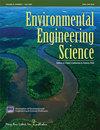Photocatalytic Performance of Boron-Doped TiO2 for Treatment of Rhodamine-B Dye and Industrial Wastewater Under Ultraviolet Irradiation
IF 1.8
4区 环境科学与生态学
Q4 ENGINEERING, ENVIRONMENTAL
引用次数: 0
Abstract
The organic dyes that have been added to water by various industrial effluents possess a serious threat to the environment due to their mutagenic character. TiO2 has been widely employed as a photocatalysis for the degradation of these dyes. However, a non-metal doped TiO2 can be a promising candidate for the advanced treatment of industrial wastewater containing organic dyes. In this work, we have prepared and tested different boron-doped TiO2 photocatalysts to examine the effect of boron addition on the photocatalytic activity of TiO2. The various boron precursors used are boric acid (BA), boron oxide (BO), and boron nitride (BN), through which Boron is formulated and is doped through a single-step sol-gel method. The prepared nanocomposites are characterized using various characterization techniques, such as Field Emission Scanning Electron Microscopy (FESEM), Transmission electron microscopy (TEM), ultraviolet-visible (UV-Vis) and Raman spectroscopy, X-ray diffraction (XRD), Fourier Transform Infrared (FTIR) spectroscopy, photoluminescence, and X-ray Photoelectron Spectroscopy (XPS) analysis. UV light of wavelength 365 nm has been used for studying the photocatalyst behavior. Both rhodamine-B (RhB) and industrial wastewater samples have been studied for degradation kinetics. The boron-doped TiO2 nanocomposites show a high level of dye degradation (>95%) with RhB dye and (>63%) with industrial wastewater samples. Further, TiO2-BA composites in both the cases showed maximum dye degradation compared with other boron nanocomposites with an enhancement in the efficiency of (>13%) over a pure phase of TiO2.硼掺杂TiO2处理罗丹明- b染料及工业废水的紫外光催化性能
各种工业废水中添加的有机染料具有诱变特性,对环境造成严重威胁。TiO2作为光催化剂已被广泛应用于这些染料的降解。然而,非金属掺杂TiO2可以成为含有机染料工业废水深度处理的有希望的候选者。在这项工作中,我们制备并测试了不同掺硼的TiO2光催化剂,以考察硼的加入对TiO2光催化活性的影响。硼的前驱体有硼酸(BA)、氧化硼(BO)和氮化硼(BN),硼是通过单步溶胶-凝胶法制备和掺杂的。利用各种表征技术,如场发射扫描电子显微镜(FESEM)、透射电子显微镜(TEM)、紫外可见(UV-Vis)和拉曼光谱、x射线衍射(XRD)、傅里叶变换红外(FTIR)光谱、光致发光和x射线光电子能谱(XPS)分析,对所制备的纳米复合材料进行了表征。用波长为365 nm的紫外光研究了光催化剂的行为。对罗丹明- b (RhB)和工业废水样品的降解动力学进行了研究。硼掺杂TiO2纳米复合材料对RhB染料和工业废水样品的染料降解率分别为>95%和>63%。此外,与其他硼纳米复合材料相比,这两种情况下的TiO2- ba复合材料都表现出最大的染料降解能力,比纯TiO2相的效率提高了(>13%)。
本文章由计算机程序翻译,如有差异,请以英文原文为准。
求助全文
约1分钟内获得全文
求助全文
来源期刊

Environmental Engineering Science
环境科学-工程:环境
CiteScore
3.90
自引率
5.60%
发文量
67
审稿时长
4.9 months
期刊介绍:
Environmental Engineering Science explores innovative solutions to problems in air, water, and land contamination and waste disposal, with coverage of climate change, environmental risk assessment and management, green technologies, sustainability, and environmental policy. Published monthly online, the Journal features applications of environmental engineering and scientific discoveries, policy issues, environmental economics, and sustainable development.
 求助内容:
求助内容: 应助结果提醒方式:
应助结果提醒方式:


